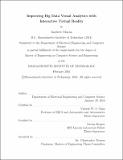Improving big data visual analytics with interactive virtual reality
Author(s)
Moran, Andrew, M. Eng. Massachusetts Institute of Technology
DownloadFull printable version (10.71Mb)
Other Contributors
Massachusetts Institute of Technology. Department of Electrical Engineering and Computer Science.
Advisor
Vincent W. S. Chan and Jeremy Kepner.
Terms of use
Metadata
Show full item recordAbstract
For decades, the growth and volume of digital data collection has made it challenging to digest large volumes of information and extract underlying structure. Coined 'Big Data', massive amounts of information has quite often been gathered inconsistently (e.g from many sources, of various forms, at different rates, etc.). These factors impede the practices of not only processing data, but also analyzing and displaying it in an efficient manner to the user. Many efforts have been completed in the data mining and visual analytics community to create effective ways to further improve analysis and achieve the knowledge desired for better understanding. Our approach for improved big data visual analytics is two-fold, focusing on both visualization and interaction. Given geo-tagged information, we are exploring the benefits of visualizing datasets in the original geospatial domain by utilizing a virtual reality platform. After running proven analytics on the data, we intend to represent the information in a more realistic 3D setting, where analysts can achieve an enhanced situational awareness and rely on familiar perceptions to draw in-depth conclusions on the dataset. In addition, developing a human-computer interface that responds to natural user actions and inputs creates a more intuitive environment. Tasks can be performed to manipulate the dataset and allow users to dive deeper upon request, adhering to desired demands and intentions. Due to the volume and popularity of social media, we developed a 3D tool visualizing Twitter on MIT's campus for analysis. Utilizing emerging technologies of today to create a fully immersive tool that promotes visualization and interaction can help ease the process of understanding and representing big data.
Description
Thesis: M. Eng., Massachusetts Institute of Technology, Department of Electrical Engineering and Computer Science, 2016. This electronic version was submitted by the student author. The certified thesis is available in the Institute Archives and Special Collections. Cataloged from student-submitted PDF version of thesis. Includes bibliographical references (pages 80-84).
Date issued
2016Department
Massachusetts Institute of Technology. Department of Electrical Engineering and Computer SciencePublisher
Massachusetts Institute of Technology
Keywords
Electrical Engineering and Computer Science.